 FILMMAKING
PHOTOGRAPHY
SAFARI
FILMMAKING
PHOTOGRAPHY
SAFARI

Between the spectacular snow-capped Himalayas to the north and the intensively farmed Gangetic Plain to the south lie the steep hill slopes and fertile valleys of Nepal’s tree rich Terai land. In the past Nepal was an extensively forested country but now with the need for the expansion of agricultural land, the growing regional demand for timber, and the local reliance on firewood as the primary source of domestic energy, less than 30% of the country’s forest cover remains.
The Terai area is rich in biodiversity and in addition to the essential tree root system that transverses the land and provides the much needed stability to the soil to prevent run-off from the annual monsoon rains, the natural forests provide a wealth of benefits to the local population including firewood, timber for construction, leaf fodder for animals to feed in the dry season and grazing land for their livestock. The land, humans, livestock and forest are all vital components of a delicate equilibrium throughout this region. However, the use of arable and forestland has tipped in favour of the mixed farming system and recent widespread logging in the southern area has resulted in deforestation and degradation being one of the biggest environmental problems in Nepal. The underlying causes for this shift are numerous and complex.
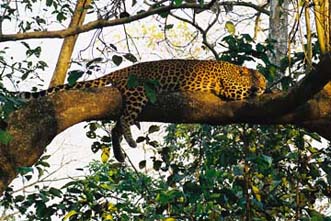
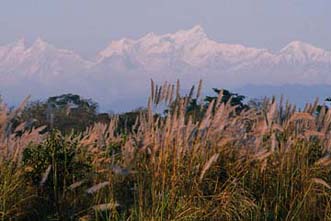

A significant number of families in Nepal depend on agriculture for their livelihood and in the past large areas of the Terai were cleared for resettlement programs, which inevitably resulted in an increase of agriculture, which has continued to expand into the steep hill slopes and marginal lands. Many of the rural people of Nepal also have insufficient land holdings for grazing and as a result domesticated herds of livestock are found grazing in forested areas with National Park status, destroying any chance for new seedlings to grow. The ever growing population of cows, water buffalo and goats, which is now comparable to the local human population, require a significant supply of palatable, tender grasses and tree fodder adding to the excessive and uncontrolled grazing in the area. Many local people who live near National Parks and Wildlife Reserves are also dependent on firewood as their only source of fuel for heating and cooking. The geographical locations place them far away from the main highways systems and in many of these locations the infrastructure is not in place for a regular supply of electricity. If people cannot afford kerosene and liquid petroleum gas they can walk or cycle to collect firewood in the forest to meet their needs and those of their families.
In areas of high unemployment the selling of timber in local towns can act as a valuable source of income. In addition, due to a prolonged period of political instability, lack of monitoring and an ever growing demand for timber from the Indian market there has been a significant increase in smuggling of sal trees across the border. The Nepalese government recently announced a temporary two-month logging ban throughout the country due to the serious concerns regarding the rate of deforestation. Forest areas are also being cleared for the building of roads, reservoirs, hydroelectricity projects and oil and mining exploitation. Mosquito suppression has also opened formerly malarial land for settlement in the Terai. The deforestation of the rich sal forests also has a significant impact on the resident wildlife that inhabits the National Parks of Nepal. Due to loss of habitat wild animals are compelled to go beyond the park boundaries on their search for food and this inevitably results in animal-human conflict. Crops are raided and there are annual incidents of people being killed by wild elephants and Indian one-horned rhinoceros, which in turn results in animals being killed. In areas such as Koshi Tappu Wildlife Reserve wild and domestic water buffaloes are interbreeding therefore making the genetically pure Wild Buffalo number in Nepal smaller and rarer. The majestic Panthera tigris numbers continue to be difficult to monitor and with the continuous erosion of this prime habitat healthy populations and genetic diversity become increasingly more difficult to sustain.

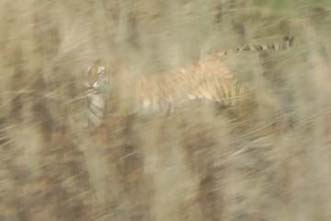

Shankar Tiwari, resident naturalist and founder of Travel Nepal Pvt. Ltd believes that alongside the negative effects on wildlife and local communities, the deforestation in Nepal is causing adverse effects on the biome as a whole. When forests are cleared the soil is exposed to the sun making it dry and infertile. Essential nutrients such as nitrogen are being lost and washed away by rainwater and because of this merely replanting trees may not be enough to solve the problem of deforestation. Erosion of the soil will also mean that crop yields will start to fall, there will be a significant increased risk of landslides, and large areas of land will be rendered permanently impoverished. Shankar also points to other long term consequences such as disruption of the natural water cycle, loss of biodiversity, flooding, drought and overall climate change.
The Government of Nepal has established Head Quarters at each of its National Parks with army and ranger posts to help prevent illegal logging and to protect the resident wildlife from poaching. Tourism plays its part in maintaining and supporting the management of these protected areas by way of entrance fees. However, hotels and lodges also demand large amounts of timber for construction and firewood for cooking and heating so deforestation continues in these areas. Biogas is a logical alternative to firewood and the introduction of improved cooking stoves would ease the demand for the hardwood. Local volunteers supported by NGOs and aid donors aim to establish new plantations, distribute seedlings to farmers and plant trees that are grown in tree nurseries for reintroduction into the Terai areas. The Forestry Sector is currently applying different strategies to cope with deforestation including the reduction of consumption of forest products, promoting community forestry, improvement of pasture and livestock management, generating employment through forest development work and reducing land tax on private forests.
Shankar Tiwari, resident naturalist and founder of Travel Nepal Pvt. Ltd believes that alongside the negative effects on wildlife and local communities, the deforestation in Nepal is causing adverse effects on the biome as a whole. When forests are cleared the soil is exposed to the sun making it dry and infertile. Essential nutrients such as nitrogen are being lost and washed away by rainwater and because of this merely replanting trees may not be enough to solve the problem of deforestation. Erosion of the soil will also mean that crop yields will start to fall, there will be a significant increased risk of landslides, and large areas of land will be rendered permanently impoverished. Shankar also points to other long term consequences such as disruption of the natural water cycle, loss of biodiversity, flooding, drought and overall climate change.
The Government of Nepal has established Head Quarters at each of its National Parks with army and ranger posts to help prevent illegal logging and to protect the resident wildlife from poaching. Tourism plays its part in maintaining and supporting the management of these protected areas by way of entrance fees. However, hotels and lodges also demand large amounts of timber for construction and firewood for cooking and heating so deforestation continues in these areas. Biogas is a logical alternative to firewood and the introduction of improved cooking stoves would ease the demand for the hardwood. Local volunteers supported by NGOs and aid donors aim to establish new plantations, distribute seedlings to farmers and plant trees that are grown in tree nurseries for reintroduction into the Terai areas. The Forestry Sector is currently applying different strategies to cope with deforestation including the reduction of consumption of forest products, promoting community forestry, improvement of pasture and livestock management, generating employment through forest development work and reducing land tax on private forests.

The staff were happy to see a familiar face from last season and we forged straight ahead into a fairly busy month welcoming guests from various nations making the long journey to this most special piece of southern Tanzanian wilderness.
It most certainly is a dry landscape that presents itself to you when you first arrive and your impression of an almost lifeless, tree-covered bush land could not be further from the truth if that is a notion that unfairly enters your mind!
I have been almost forcefully thrust back into the violent world of lions with a pride-war having taken place only a few kilometers from camp last week leaving two lion cubs dead and consumed by the resident clan of Spotted Hyena and a giraffe kill on the same day with members of both prides fighting over the spoils. A somewhat macabre re-introduction back into the reality of wildlife...there certainly doesn't exist a more accurate axiom in the description of nature in the raw than "beauty is in the eye of the beholder". Our eyes behold an intense and unconcealed beauty, so honest in its existence that it almost never fails to fascinate the human soul that allows it entrance. The creatures for the most part are habitual and reactive; we are more intelligently perceptive and thoughtful...from the safe confines of our vehicle it should be added!
Leopards have graced us with a glimpse of their beautiful but fearfully well-camouflaged coats, mostly up in the tall and majestic Baobab and Sausage Trees, which abound here. The image above shows one such leopardess pausing momentarily before slinking down her chosen arboreal perch with her sharp claws audibly ripping pieces of the bark from the bole to go off and hunt her dinner. There must be death for life to thrive.
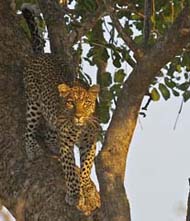
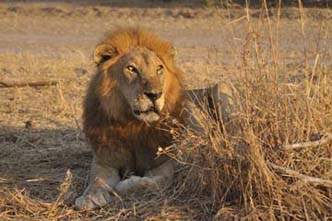
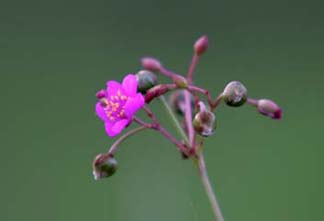
However dusty, spring is erupting with a slow but definite emergence of flowers and new green leaves, predominantly on the Bush willows which are being heavily targeted by browsers such as Greater and Lesser Kudu, Impala and Giraffe. To watch a gigantic giraffe at close quarters using its long tongue and mobile lips to take in its sustenance is an amazing experience. Interesting bird sightings have included Martial Eagle hunting Helmeted Guinea-fowl, Mottled Spine-tails circling above the Baobabs and a myriad of White-backed and Hooded Vultures cleaning up what the predators leave behind after their dastardly deeds. Too many more to mention... A strange phenomenon beheld our attention for some time a few days ago, the exact nature of which I am still to ascertain: large, flat, silken "patches" on the boles of Baobabs west and south of the Ikuka forest, filled with hundreds of cream-coloured larvae wriggling about having being disturbed y the hand of an inquisitive group of humans! I have not seen them anywhere else here in our entire area, save one or two at the most. Watch this space.
Clouds are building at the end of every second or third day now, big, dark ones.
The promise of rain, perhaps sooner than expected; a few drops fell to our dusty feet today...
Till next time

A drop of rain falling onto the dry ground is like cold water being poured into a glass destined for your lips: it provides sustenance and renews life, it cools and it cleans; its vital, critical. We sometimes take that for granted, especially since many human lives are so viscerally separated from the real and tactile significance of it... yet it is by a very great measure, probably the most single important resource human beings have for their survival. Indeed, for the survival, growth and reproduction of almost every other living creature on planet earth. And so, Ruaha is wet and lush and verdant now and a renewal of life — with a little death thrown in for good measure — is taking place at a breathtaking pace.


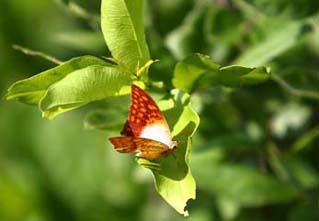
We are daily witnessing butterflies & bees and all manner of nature's inordinate fondness for 'small life forms' busy about their daily activities and replicating their kind in almost every corner of the landscape — what an incredible eruption of colour and movement! Witnessing the tail-end migration of Common & Brown-veined White butterflies drifting across the woodlands reminds one of snowfall almost they are so numerous! Perching on every object from their specific host plants to lion scat provides for interest and entertainment and wonderful photo opportunities.
The grass has become a verdant ocean drifting and swaying in the afternoon breeze, whilst Kudu and Giraffe even partake in ingesting some of its sustaining goodness, a broad departure from their otherwise obligatory diet of bushes and trees.
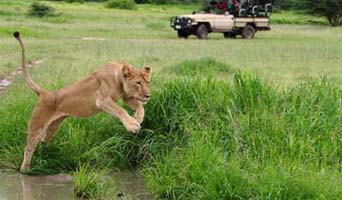
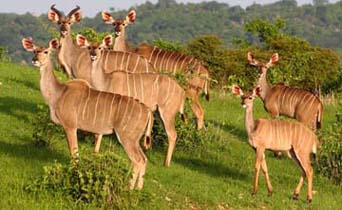
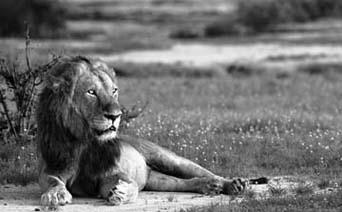
Watching lions hunting Lesser Kudu, Impala and Giraffe here over the last month has provided us with dropped-jaw excitement at times, and they have in so doing not failed to enthrall and draw the gaze of our guests who have the good fortune to come and stay for a while with us. January has seen a drop in leopard sightings but we have had 3 memorable experiences with these "Princes of Darkness", once a leopardess deciding she 'liked' the vehicle and stayed walking around investigating the environment for some time, rolling on the ground, stalking prey, staring at the tyres (fascinating for leopards you know!) and then sauntering off into the savanna. A few steps and all that is seen is the white tip on her active "tell-tail" drifting effortlessly... silently... through the long grass. "Death in the Long Grass" to borrow a phrase from another writer.
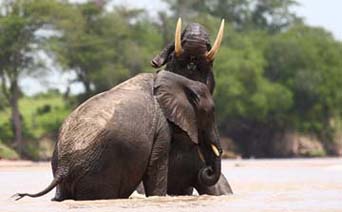
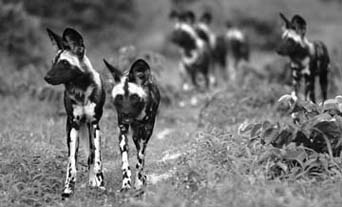
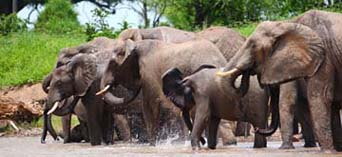
Elephants have been numerous and beautiful to spend time with in this stunning landscape of running rivers, mud and soft rain. We got a little wet... so what? So did the elephants! So many antelope and other larger game species, elephants certainly not excluded, are so enjoying the absolute abundance of food that surrounds them that they are engaged in social activity for much of the time. Watching baby elephant go to sleep at the feet of their mothers; and at other times having the "free time" to push and thump each other around, play in the water and mud and soft cool sand, allows one to really take a look through the proverbial 'keyhole' into their lives! Spending time with these animals, great and small, is what turns an ordinary 'game drive' into something more, an experience with nature, a chance to spend some 'oblivious time' in the "now" where you forget everything else and witness a spectacle which brings a smile to your face but pushes that smile deeper down. Elephant have the capacity, through our knowledge of their exceptional intelligence and their obvious gargantuan proportions, to really slow us down and make us start taking notice of beauty just for the sake of it, silence for the calmness of it, sound for the feeling of it and awe that something could be so big and yet so gentle. Delicate almost. The 28th of January was exceptional... over 25 different herds of elephant in one morning!!! The day before in the same area... one solitary, lonely bull!

Recently, Ruaha has become almost overrun by those great, grey ghosts of the night called Elephant. They are literally almost everywhere, pervading and permeating every woodland, grassland, forest and riparian habitat this Eden provides for their hungry mouths and stomachs! And then...poof! They are gone, magically and silently disappearing overnight into the heart of this great wilderness leaving behind only the traces and signs that reveal their recent nocturnal presence and activity.

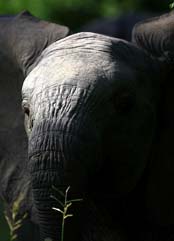
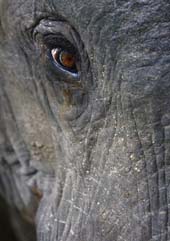
Sometimes my guests think I’ve had a few morning shots of fine Irish because I’m all over the road, swinging the car left and right (it’s gentler than you think!) as we discover and read last-night’s “newspaper”...only we’re dodging all the dung left by the huge beasts lying everywhere on the track before us! Dung-beetles (and other insect attendants attracted to such excrement) have right of way here and we try to respect their culinary and reproductive resources - it’s the rule of the road and we try to be as respectful as possible. And besides, it’s fun!!
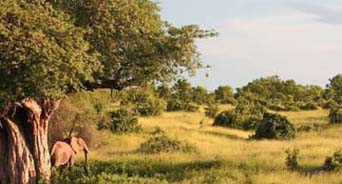
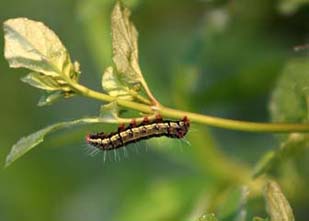
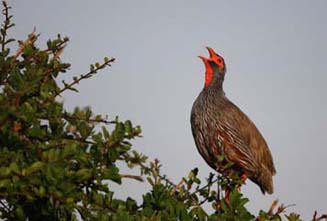
The fact that we are in the middle of the ‘Emerald Season’ here means that almost everything around us is verdant, bright, clear, new and punctuated by sometimes spellbinding colour. Plants are reproducing at a breathtaking pace and in so doing bear a profusion of bright colour in their fine flowers with many different fruit now being borne on heavy boughs dripping with morning dew. Everything sparkles and is unmistakably alive!
On our ‘discoveries’ (game-drives) we have been fortunate to witness and experience wonderful spectacles, including many interacting mammals. A few weeks ago we had just passed over the Mwagusi bridge after having spent some time observing and laughing at a troop of Yellow Baboons lounging around on the sandy bed of the river as if they were on a beach in Brazil, and began looking for a ‘picnic spot’ to enjoy a breakfast in the shade when we stopped at a herd of Impala. Their graceful bodies were illuminated by the late-morning sun which was shining in individual rays through a grove of Baobabs they were feeding under - what a sight, we couldn’t just drive by! A few Impala up ahead began shouting a little half-heartedly at something and we took notice, enough to start up and proceed forward very slowly and see what spectacle might unfurl before us.
A little further on we saw the vociferous Impala and followed their gaze carefully into the green grass...lions! One lioness and two attendant males, one of which was courting the lady-lion due to his very close proximity to her and the other male’s more distant location.
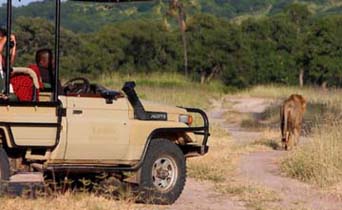
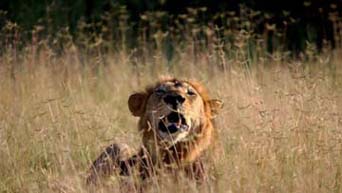
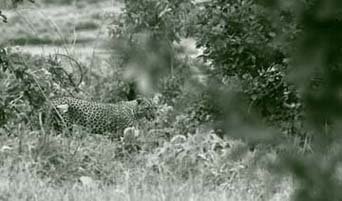
After sitting and watching a while with the feline couple copulating a few times we heard a distant branch break only to discover that a large herd of elephant were on their way...on a direct trajectory toward the cats laying before us!
Here comes some action - and our educated assumption wasn’t off the mark! The elephant proceeded forward and the two amatory lion became increasingly nervous and began to growl in their frustration that today they were not to be “king of the jungle” but rather “scare-dy cats”, eventually running away with the elephants charging and trumpeting after them at great speed! The aural bombardment we were being happily subjected to leapt to a higher level because the running lions started roaring at the top of their lungs displaying their extreme displeasure at being evicted from their honeymoon copse under the shady baobabs!
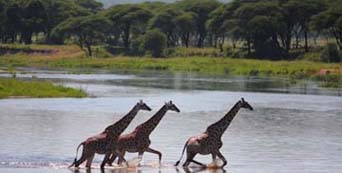
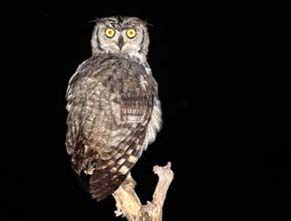
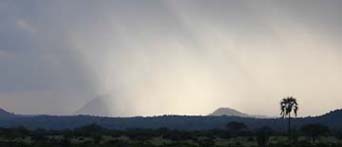
After that we really should have brought a shot of good Irish along to douse the coffee we enjoyed a few minutes afterward under our own shady wood further on...excellent! Back to butterflies and birds on the way back to camp, we said...but we didn’t get very far with that because we had to endure a traffic jam or three on our return. ELEPHANTS!!

Both myself and wildlife photographer Valji Varia (UK) have always been lucky to see big cats together on many occasions since we first explored the Nepalese terai together in 2004. Even in Chitwan National Park we have been fortunate enough to see both Tigers and Leopards! Our most recent trip together was to Bardia National Park, which delivered the best results ever with 6 individual tigers seen 10 times in a period of 7 days (including a mother and 3 cubs).
Valji is very passionate about Big Cats and has visited many counties to see these magnificent felines throughout Africa, India, Sri Lanka and Nepal. After all his experiences of Big Cat encounters and other wildlife Valji proudly states that only in Nepal will one witness the essence and true wild behaviour of the Royal Bengal Tiger. On the morning of 23rd April we boarded our light aircraft to Nepalgunj, a flight of approximately one hour with Buddha Air, which also offers fantastic views of the high snow-capped Annupurna mountain range. The intense heat in Nepalgunj is in sharp contrast to the relatively mild conditions in Kathmandu but we were happy as it is this type of extreme heat that we hoped would bring the tigers out to the rich network of waterways from the mighty Karnali River and result in some opportunities to photograph the Bengal Tiger.
On route to Karnali Lodge we stopped at the Babai River and took pictures of big Marsh Mugger and Gharial Crocodiles as well and scenic views of the very edge of Bardia National Park. There was a warm welcome from the staff as we entered the lodge and we also heard the latest news from a scientific team that were about to leave who said that their census in the park identified 47 Wild Elephants (the biggest number of Wild Elephant they have ever counted) as well as a few tiger sightings. We were very excited about exploring the Park that afternoon and could hardly wait till 3.30pm for the first of our 16 elephant safaris.
Our mahout (elephant driver) led the elephant toward the deep wild forests of Bardia National Park, which has an increasing reputation for wild tiger encounters. While on elephant back we wasted no opportunity and began an intense search for wildlife. After exiting an area of tall elephant grass we were suddenly rewarded with some fresh pug marks of tigers which we promptly began to follow. The Mahout whispered to us that this pug mark a mother and three cubs which had been seen a couple of days back. As we travelled through the jungle we also spotted some nice birds including the Great Slaty Woodpecker, Chestnut-capped Babbler, Yellow-bellied Prinia and many more. Our excitement grew as we entered the forest with bamboo cane and searched on all four sides for a glimpse of the bright orange and black stripe markings through the dense foliage. We continued to follow the pug marks and then all of a sudden we heard the alarm call from a spotted deer a little further ahead! We felt we were very close to a tiger and our mahout began to take our elephant faster and faster through the thick forest.

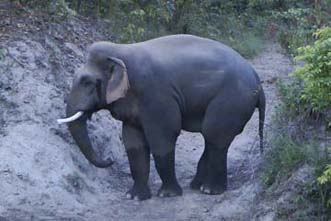

As our excitement continued to build we thought we may be lucky enough to spot one but the bush was very thick making a visual extremely difficult. In addition the tigers were very clever and working hard to escape our keen eyes, much to our frustration! Time went past so quickly in our quest to view the tiger that we could already see the sun setting down through gaps in the forest canopy and so sadly we had to turn back to our lodge. On reaching a small waterhole in the grassland near to the edge of the forest we were rewarded with a sighting of a mother and baby one-horned rhinoceros bathing. Soon after, and as we were about to cross one final river to finish the elephant safari, to our amazement we encountered a huge bull elephant named Bahadur Gaj. He was in an aggressive mood, displaying the tell tail signs of musth. While our elephant was about to take a drink from the river Bahadur Gaj began to charge! Our Mahout demanded that our elephant run fast enough to get away from the big bull and our poor Kali had to run carrying the weight of four adults and the heavy hauda seat! Luckily for us she was extremely strong and we managed to escape from the large bull and lost him in the thick foliage lining the river bank. That was close! And enough excitement for the first afternoon elephant safari in the stunning Bardia National Park.
Very early the next morning after coffee and cake we are in the forest again enjoying our elephant ride in search of the mother tigress with cubs. Again, we found fresh pug marks but no visual. We did however see two impressive big bull elephants and also a Brown Fish Owl being chased by Large-billed Crows. After Breakfast we drove to the river point which we then crossed by foot as it was too deep for the jeep. We then continued to trek through the forest for about 10 minutes to get to the second river bank and walked along the river where we saw another very big wild bull elephant known as Rajiv. He was standing in the river and eating fresh grasses. At times, Rajiv sensed that we were present and so it was very important that we kept our wits about us... We sometimes had to walk faster away from him then he stopped then again we stopped... This really was an adventure! After a while Rajiv left the river bank and entered the jungle. We remained on the bank and observed Langur Monkeys, Rhesus Macaque, Wild Boar and many nice birds.
In the afternoon we again went in search of tiger by elephant safari. This time we all had a very strong feeling that the tiger family were still in the same area and so asked the Mahout to lead our elephant directly to the same spot that we had seen the pug marks in the morning. On our way we saw a breeding herd of wild elephant made up of four young males, several females and the biggest bull male we have ever seen in the park! We knew that this could potentially be an extremely dangerous situation and so kept our distance. A rhino was also enjoying his graze nearby but we were concentrating solely on the elephants. Valji was attempting to capture some interesting images of wild elephant behaviour when all of a sudden the big bull elephant noticed we were there and started to charge us! Luckily we had kept our distance so had some breathing space but when we stopped we realised that the bull was still pursuing us! The chase led us directly into the area where the tigers had been spotted several days ago and thank God at the same time the bull gave up his pursuit of us. Alas, we felt safe again... But wait... All of a sudden we saw tigers coming out from the thorny Bamboo bush in the deep ditch below us! What a sight! Four tigers running around in a maze of foliage! Two tigers ran very fast to the other side of the ditch, one sat on the far bank, which was only about 12-15 meters away from us and the fourth was still down in the ditch barely visible through the dense bush. They were all around us but where to look? We had good visuals of two of them from our elephant and Valji was busy trying to capture these magnificent animals on video. Soon after, the young tiger in the ditch roared very aggressively and ran very fast towards the others. Their mother was concerned for the safety of her cubs and ran directly toward the youngster who had roared at which point we managed to see her entire body in a flash of deep orange and black stripes, stunning!
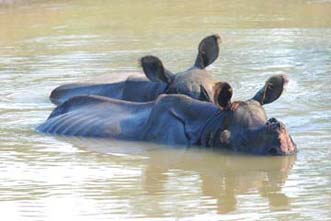


The habitat in which they were resting was perfect, secure, hidden, a roof of thorny bamboo bush where not even elephants would dare to go. The ground was damp and open so that the tigers would feel cool in the intense heat.... one would not find a better place for a tiger to rest and so we named the location 'Tiger Palace'. What an encounter with the real wild tigers of Nepal... amazing! and so difficult to explain the feeling of excitement, thrill and danger in words! The Bardia National Park truly is a haven for the panthera tigris and the sight of cubs gives hope for future generations of this beautiful cat.
After sometime we moved away from the area to avoid any further disturbance of the family of tigers. Three hours felt like three minutes after this encounter! As we headed back to the lodge we saw a rhino walking in the river. He sat down, showing only his head and upper back. As we got ever closer the rhino stood up and started to wade through the water, up the river bank and then out of sight into the jungle. We also saw Large-tailed Nightjar, Pied Kingfisher, Pintail Green Pigeon, Orange-breasted Green Pigeon and many more species of avifauna.
The next day we again were on elephant back but decided to explore the northern part of the park where we have not been. We also wanted to avoid the previous area so as to limit the level of disturbance to the tigress and her cubs. We had a wonderful safari along the river and through riverine forest and grassland. There we spotted many other animals including Swamp Deer, Hog Deer, Spotted Deer, Sambar Deer, Common Langur Monkey, Rhesus Macaque, and the unusual behaviour of 11 smooth-coated Otters. The mother otter actually ran toward us trying to defend her family! On seeing the otter charge, our elephant made a deep blowing sound through its trunk at which point the otter realised that she had met her match and made a dramatic U-turn! Along the river we also saw Stork-billed Kingfisher, Eurasian Kingfisher, Brown-headed Barbet, and Oriental Pied Hornbill. In the afternoon we tried our very best to track down the tigers but with no luck. However, the elephant safaris were very enjoyable with many herbivores and birds on display including the Changeable Hawk Eagle, Large-tailed Nightjar and Savanna Nightjar. We also tracked down four rhinos with one very small baby rhino and a porcupine.
Our elephant safari started very early the next morning to search for our elusive tigers. Valji, our mahout, our guide, and myself were extremely focused this morning on tracking down a big cat. After only 15 minutes we came across fresh pug marks on the dirt track, followed by alarm calls of both chital and Langur monkey. As we moved ever closer to the commotion we passed fresh tiger scratch marks on a huge sal tree... the tiger was marking its territory! We closely observed the Langur monkey to identify the direction in which it was looking which led us into some very thick bush. After some time we found the remains of a kill including the skull and part of the limbs of a spotted deer. Unfortunately the shrub was so thick we were unable to gain a visual of the tiger nearby. At the end of the elephant safari we decided to have breakfast on the river bank and waited patiently for a glimpse of the tiger, again with no luck but our determination for a sighting was strong as ever and we prepared ourselves for our afternoon activity.
As we started our safari are diligence was again rewarded with a series of alarm calls and as per usual we went to investigate. As soon as we reached the track we saw very fresh pug marks.... no more than ten minutes old! We set off in pursuit being careful to not make any noise and carefully followed in the direction of the pug marks. We then came across fresh blood on the road and the drag marks of a kill. We all sensed the tiger was very close by and headed into the dense bush in the direction of the kill. Only three meters in we found a fresh spotted deer kill. All of a sudden the mahout pointed into the thick undergrowth and there he was.... a huge male Bengal Tiger! We could only see his sharp steely eyes and the white of his forelegs... he was very irritated as we were next to his kill and began to move his tail from side to side. He then began to growl to express his anger and like lightning charged a distance of 20 meters with great speed and an enormous roar! He then changed direction and came back at us with a second deafening roar. Wow! What an amazing encounter and what a magnificent beast... a demonstration of pure natural power and aggression. I was so happy and said thank you to nature for such a wonderful experience for Valji and I..... I am so proud that we have National Parks and can support conservation work..... How else could people like us who share such a deep passion for nature experience moments such as this... absolutely amazing!
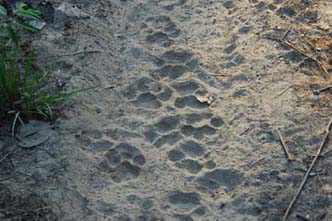

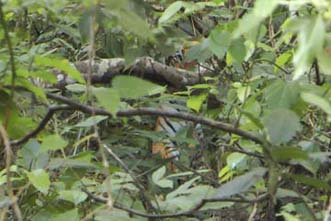
We decided to move back and keep our distance from the chital kill. We then made the decision to move around the block to see if the tiger would come out again and headed toward the river bank from where we again entered the zone where we spotted the tiger. On our return the kill had been moved! In the space of 20 minutes the tiger had disemboweled the deer and dragged the kill about 15 meters across to the other side of the track. As soon as he heard us returning he abandoned the kill and hid in the foliage. We decided to leave him in peace to enjoy his kill and wait for him on the river bank incase he comes for water after eating his fill of fresh meat. After a couple of hours we made the assumption that the tiger had visited an alternative water source and so headed back for the location where we had last seen the kill. However, when we arrived the kill was no longer there! We searched for drag marks in the bush but with no luck. We had no idea but the tiger had in fact dragged the kill to the other side of the road again. This tiger was also extremely cunning, as he had gone over the same drag mark that he had created earlier! What a clever cat. Once we had worked out how this tiger had tried to confuse us we got onto the correct side of the road and followed the drag marks along some very think bush. We decided to climb a tree and wait patiently for the tiger to return. It was a great experience to be that close to nature and wait in silence for the apex predator to return. Valji knew that this tiger was very clever and did not think that the tiger would return with us so close by, even though we were no longer on elephant back but on a tree! As we expected, the tiger did not return but we could hear him growling in the distance and so he clearly knew that we were there! What an adventure!
The next morning we took a raft on the Khaura River. This was very enjoyable and relaxing as we floated along the river through some amazing forest on the crystal clear water enjoying sightings of spotted deer, swamp deer, Langur monkey and many beautiful birds including White-throated Kingfisher, Stork-billed Kingfisher, Crested Serpent Eagle and many more species of avifauna. Our final afternoon safari awaited us and Valji was determined to track down a tiger! Our brave elephant Saraswoti arrived at 3.30pm with her mahout along the edge of forest and river to help us in our quest for one last memorable encounter. We headed directly for the 'tiger palace' where we had previously had good luck for seeing tigers. As we moved towards the area we began to hear alarm calls repeatedly. Our mahout was commanding Saraswoti to move faster in the direction of the alarm calls and then all of a sudden his eagle eyes spotted a tiger! The tiger was hunting and stalking hog deer in the tall grass in which he was extremely well camouflaged. We tried our very best to keep the tiger in our sights and luckily there was a luga with shorter grass in which the tiger entered and we were thus able to work out the direction that he was heading in.
The tiger crossed a dry river bed in pursuit of his prey and we followed. We carefully circled the area and after some time found him though the visibility was very difficult as he was hidden in some very think bush. After a further thirty minutes the tiger moved into an area of thick grassland... our patience had paid off as now he was much easier to see and his majestic coat was in full view. As we moved closer the tiger began to display warning signs, showing his canines and growling slowly. There was only open ground of approximately 20 meters between the tiger and ourselves, it was a special moment and we were all wondering what he was going to do next! It was clear that he did not want to leave the area for some reason and there were many deer in our vicinity. We maintained our position and our elephant Saraswoti Kali began to sway her trunk and noisily pull on the nearby shoot of grass. This was the catalyst for the tiger to make its move and irritated by the noise he suddenly charged directly toward us with a huge roar that echoed around us! The power and speed that he was moving at formed a trail of dust behind him and as he approached our elephant he turned to his right into the long grass.
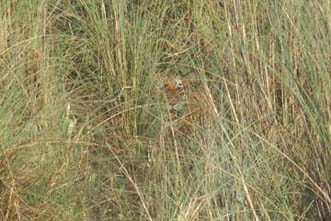


To see this in the open was an absolutely fantastic experience and one I will never forget. Even though I was feeling scared at the same time I also felt a sense of excitement. This is a special moment and one I hope many wildlife enthusiasts will have the opportunity to experience and capped off an outstanding tiger encounter! After the thrill of the charge we decided to leave the tiger in peace but then within a couple of minutes of moving away we saw drag marks which led us to a fresh kill of a male hog deer. This explained why the tiger was reluctant to leave the area and the reason he was so irritated with us being there! As the sunset we decided to return to the area the next morning to see if we could find the remains of the kill.... what a day, what a safari.
This was our final safari in the Bardia National Park and we decided that we would just enjoy the beauty of the place and the experience of being in this prime wilderness habitat. Of course we had to scan the area of yesterday afternoon's tiger encounter and to our surprise the tiger had consumed the entire hog deer kill! Only the skull, parts of the hoof and some of the intestine remained. He had consumed at least 25kg of meat overnight, what an amazing animal and the most rewarding of apex predators to witness in the wild. If Valji and I had our way we would search for tigers everyday in this stunning location. After leaving the area we passed peacefully along the river bank identifying birds and listening to the various calls of the numerous species of wildlife. We then climbed to the summit of bagh machan and said our farewells to this jewel of a park in the heart of Nepal.
Overall our visit to Bardia National Park was a huge success, we enjoyed each and every safari and even though a couple of days were quiet in terms of tiger sightings, encounters with the various other mammal species that inhabit the park were exceptional. Our list of species identified included: Royal Bengal Tiger, Elephant, One horned rhinoceros, Sambar, Barha-singa, Spotted Deer, Hog Deer, Indian Muntjack, Asian Porcupine, Langur Monkey, Rhesus Macaque, Smooth-coated Otter, Marsh Mugger Crocodile, Gharial Crocodile, Common Mongoose, Soft-shelled Tortoise, Indian Rock Python, Burmese Python, Rat Snake, Fishes and many more small mammals and avifauna including the Great hornbill, Oriental Pied Hornbill, Grey Hornbill, Great Slaty Woodpecker, Greater Flameback, Himalayan Flameback, Black-rumped Flameback, Greater Racket-tailed Drongo, River Lapwing and many more…..

Since the very first time I was drawn to the ecology and sheer diversity of flora and fauna of the South Luangwa National Park, I have always explained to my guests that it is really important to always be on the look, not only on the ground but also in the trees. As we were meandering around the area one of my guests spotted a cat in a tree in the distance. Everyone was excited to see their first leopard of the safari but as we got closer I realized that the feline had no ‘spots’. To our surprise it was a lioness sitting on the branch of the tree! What a wonderful sighting to see this ‘tree-climbing’ lion. It is always a pleasant surprise when nature tests our presumptions!
For many years scientists have reported that elephants remember the place that family members died. They are extremely intelligent and highly emotional pachyderms. On one beautiful summer morning we could see vultures circling and decided to investigate further. While driving slowly towards the scene, we saw a huge cloud of dust in the air and then suddenly a herd of elephant emerged. They were all huddled very tightly and acting restless and being very vocal. In the middle we glimpsed a tiny new born, with fresh blood visible on the hind legs of the mother. After sometime we began to realize that the baby was not moving and that it was in fact still born.
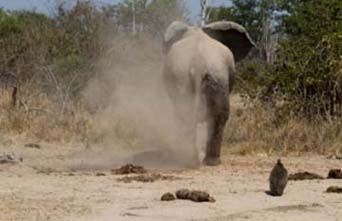
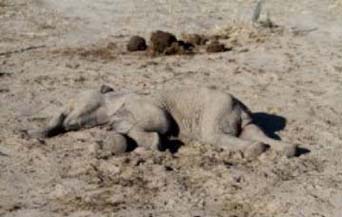
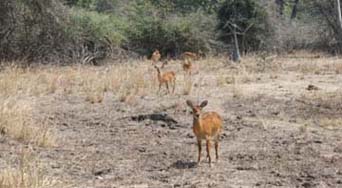
The rest of the herd were clearly helping the mother and behaving in a very protective and defensive manner, trying hopelessly to awaken the baby and looking for signs of life. The mother kept on throwing dust on both herself and her still born calf to no effect. She also dusted the area between her hind legs and over the after birth, maybe a natural response to prevent attracting predators and scavengers to the smell of fresh blood. The mother continued to rest her trunk on the baby’s belly, checking for any sign of life. She also gently used the tip of her right leg to feel for any vibrations or maybe a heart beat of the newborn. Eventually, the herd and then the mother moved away and hyena and vultures arrived to complete the circle of life.
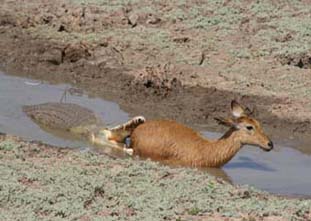
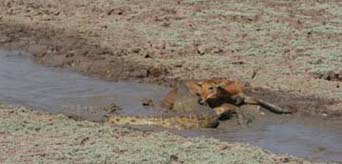

The South Luangwa Nation Park is a haven for the puku. The puku is very water dependent and frequently visits the waterholes throughout the day. However, today was a very different day for one particular puku as here be crocodiles on a particular stretch of the river. One particular reptile was patiently waiting like a dead piece of wood close to the waters edge. As usual the puku took their time to approach the water checking for danger constantly. The first drank successfully but as the second puku approached the crocodile pounced with deadly speed and brought down the unfortunate herbivore. A second crocodile was attracted by all of the commotion and violent thrashing at the waters edge. A tug of war began with the puku still alive and calling in distress, its fate sealed. It was dragged further and further into the deeper water. The crocodiles began to spin and tear off the body parts of their prey.

A return to the Ruaha is always special for me no matter what the season! There are always amazing spectacles to behold and experience, from the tiniest of creatures to the greatest leviathans walking the wilderness here. Once again, Ruaha never fails to disappoint the diligent observer of nature or a relaxed mind allowing colour, sound and scent to envelop and infuse the senses!
Arriving to take over the reigns from Marc on December 1st, I was struck by a landscape attempting to extricate itself from the hot and parched grip of the dry season, a little rainfall having been felt only a short while before, as the wheels of the Cessna Caravan hit the deck at Msembe, Park HQ. The Great Ruaha River was still “dry,” with only some isolated hippo pools and water flowing beneath the seemingly desolate expanse of its long, sandy bed. Shoots of green were only just appearing at the soil-atmosphere interface, blasted pitifully by the hot rays of the sun overhead and unshaded by what few green leaves were appearing on the trees.

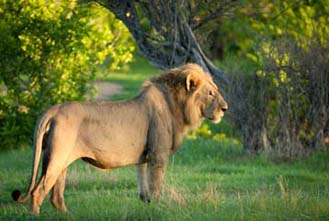
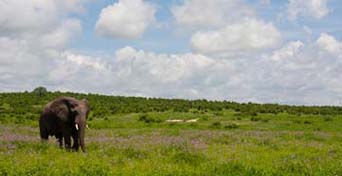
A new chapter of renewal and reproduction was emerging then, and as I write this now Ruaha is a fully fledged emerald savanna of almost blindingly bright colour, verdant open plains, thickly wooded riverine habitats and rocky fortresses that play habitat & host to her many and varied wild inhabitants struggling for survival every hour of every day.
The green season has always been said to be “quiet” and fraught with “difficulty to spot game,” and although this is partly and only slightly true, such opinions extolled with so much zeal are, I humbly opine, greatly over-exaggerated!
We have enjoyed the ever-increasing population of elephant here every day of the season, every outing producing a view and an encounter, the sounds and scent of which we allowed to wash over us, all our senses bombarded and simultaneously caressed by the audible deep rumblings, collected and masticated vegetation and soft footfalls of these great pachyderms. Wow! These huge beasts gave an experience beyond the wildest imaginations of many of our guests, often walking past, feeding, playing, mud & dust-bathing & sleeping around us…peaceful, quiet… sometimes with a little tension or a brief charge to cut the atmosphere crisply and remind us of our frailty.
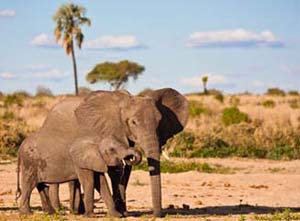
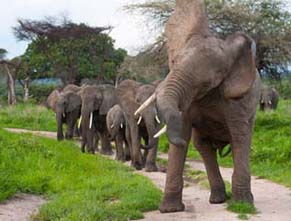
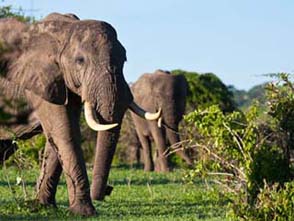
One young cow broke away from her small group who were grazing peacefully en-route down to the Mwagusi valley and approached us in a very relaxed manner, as is fairly normal with individuals who are inquisitive or just want to get to “that” bush for a quick “bite”, with the vehicle being inconsequential nor a point of interest. She stopped short of the vehicle and became mildly interested in us but then proceeded to act in a manner quite unusual: Getting down on her knees several times, flapping her ears, throwing her trunk around almost uncontrollably with a few droplets of water landing on us, digging her single tusk into the ground repeatedly to dislodge and break up some clay at the edge of the puddle! It went on and on for almost twenty minutes with us agog and very amused, laughing all the while! She almost seemed to enjoy her audience, reacting to the favorable laughs and silent applause from her human spectators… We could have shouted at her or moved away but we just allowed her to “behave” like a naughty girl and were rewarded with an incredible experience never to be forgotten.
Many other wonderful animal sightings in a rapidly changing landscape were enjoyed by everyone who had the good fortune to choose Ruaha as part of their African safari itinerary. Rainfall was softening everything, allowing green life to flourish and with it all that depended on such an eruption of verdant and lush vegetation. Wild flowers were sprouting forth, grasses growing inches by the week and a myriad of colourful insects erupting from their respective births and hiding places, showed us just how brilliant nature is at reproducing en masse.
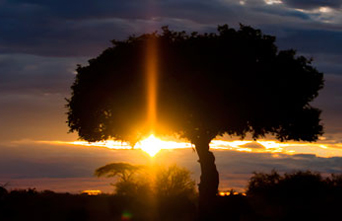
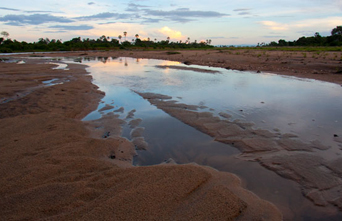
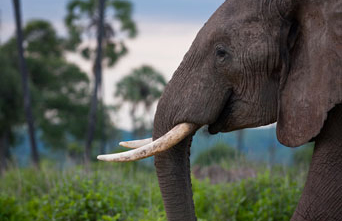
We had the privilege of viewing a group of nearly 20 Wild Dog on one occasion, the first sighting of the entire season! These hunting dogs, if their condition is any indication of the general health of the entire Wild Dog population in the greater Ruaha ecosystem, are doing very well with shiny coats and alert, inquisitive behavior! On the run, their fit and lithe bodies flow through the savanna and bush almost effortlessly in search of prey to hunt down. And with no shortage of prey around the dogs seem to be on a winning wicket at the moment, Impala antelope giving birth to their lambs in great profusion at this time of year – they were almost everywhere! The plight of Wild Dogs surviving naturally is a serious one, most intricately linked with their requirement of suitable and extensive habitat in which to thrive, Ruaha providing one of the very few massive areas in which they have the freedom to do so.
Tanzanian National Parks have taken the steps necessary to ensure that this remains a healthy and thriving ecosystem for wild life and natural processes having recently expanded the borders of the park in the south to make it Tanzania’s largest National Park at just over 20 000 square kilometers. Wild Dogs need space and prey, they have it here!
During this beautiful part of the season we really had no problems at all viewing so many different antelope, warthogs, as well as many zebra and some Cape buffalo too – usually very scarce at this time of year in the Mwagusi /
Ruaha valleys. Our time spent viewing these animals in their natural habitat was unimpeded by lush vegetation now growing with more intensity than ever before, but rather accentuated and made all the more beautiful to appreciate and photograph due to their verdant surroundings.
The “emerald season” as it is rapidly coming to be more widely known, for me is really the season to experience a diversity of nature and activity not seen during the dry time of the year. Sure, cat sightings in general do drop, but only slightly, and the photographs of cheetah and lion illustrate the beauty of their home.
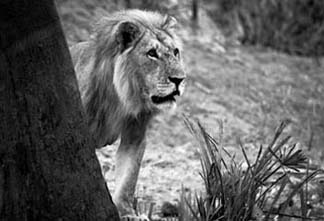
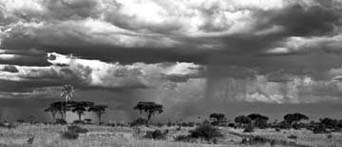

Cheetah in particular were conspicuous by their presence and we had many occasions to view them in pristine surroundings, full of life and vigor!
One day we came across a mother Cheetah and her three cubs (almost a year old) and watched them for some time until they eventually spotted a group of unsuspecting Impala and the mother cat gave chase with the youngsters having being told to “sit and stay!” The entire hunt was laid open before us and the lithe adult cat was successful, her efforts being rewarded with a well placed paw after an 80m sprint to bring down a fat, young Impala ram!
We sat for another few hours experiencing the vocalisations between the cheetah, dragging and feeding on the carcass, the first few vultures arriving and their eventual departure later on to frolic in the cool sand of the Mwagusi! Not something you see every day!
Nesting & newly arriving migratory birds filling the air with song and wing-beat added massively to the general observation of rejuvenation and rebirth at Ruaha – the Paradise Flycatchers were particularly eager in their efforts to raise young in three separate nests we found just within the camp area! Hundreds of Amur Falcons arriving on storm fronts, Abdim’s and White Storks floating in hundreds on rising thermal columns of air, Ostrich searching for food with their youngsters through the open plains – there are too many bird sightings and species seen to list them here. Suffice it to say that it’s more important to wonder at the colour and song of countless different types of bird than to list their individual names; to do so sometimes categorises them too scientifically, almost robbing us of a sense of wonder and mystery we should feel when our eyes first gaze upon their immaculate plumage!
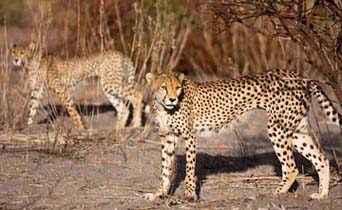
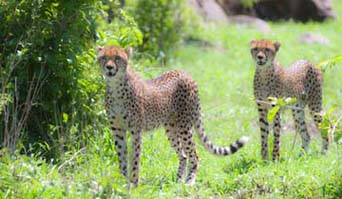
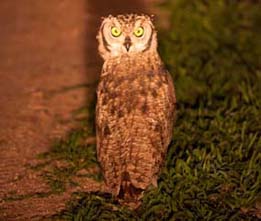
So, with the ‘greening of Ruaha’ in full swing, bursting with life in every corner, refreshing and essential rain falling every once in a while, (sometimes on our heads while watching elephants!) might mean for some an ‘intrusion’ or a ‘slight inconvenience’; we in fact believe it to be one of the best times to visit this beautiful and awe-inspiring wilderness, one of Africa’s greatest wildlife hotspots!

As the sun shinned on another beautiful morning in this oasis in Africa we explored the bush to a chorus of bush melodies from the vast array of bird species that call the Luangwa valley home. After a short while the tranquility was suddenly broken by a crushing sound and as we arrived at the water hole we were amazed to see an awesome fight between two male hippo. The South Luangwa had one of highest concentration of hippo in Africa and the beach master is often kept busy during the dry season defending his territory against would be intruders.
Often males will rise against the dominant males and this can result in often violent fights to the deaths. In 2009 I witnessed two males that fought for almost 5 hours during which they covered a distance of about 2 km while fighting. The fight came to an end when the challenger became exhausted and later died. Its bones are still lying by the roadside along airstrip short cut loop.
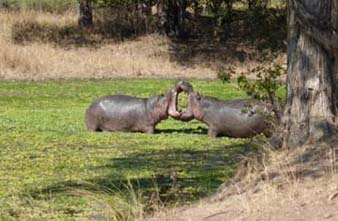
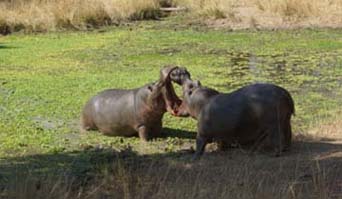
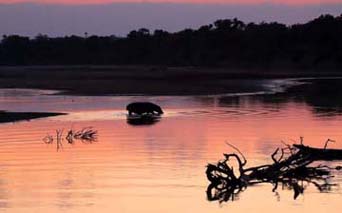
These amazing mammals have ever growing incisors and canines, which are often used in dominance displays, and posturing with wide opening of the mouth up to 150 degrees. In fights these lethal weapons can result in severe wounds and blood loss. Hippos normally live for 40-45 years and spend much of their time in water to protect the skin from the sun. They secrete hipposudoric acid which is a red pigment also known as ‘blood sweat’. It functions both as a natural sunscreen and as an antimicrobial agent. Hippo generally come out to forage at night when there sensitive skin is not exposed to the sun.
Later in our game drive we came across an old fallen tree ahead of us, lying beside the road. From the corner of my eye I spotted a side stripped grass snake. The snake was moving slowly and very steadily in the characteristic predator like behavior. As we looked a little further ahead we suddenly saw a rodent and then like lighting the snake attacked and caught the rat! The speed at which the snake captured the rat was awesome and can strike at speeds of up to 80km/h. While the snake was holding onto its freshly caught meal a brown snake eagle suddenly appeared and swooped down to make a quick steal. Fortunately for the snake its heightened senses had spotted the danger and it quickly disappeared into the under growth.
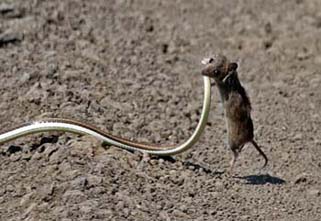
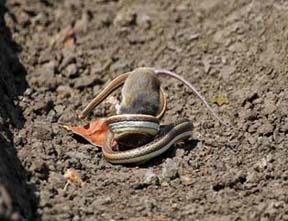
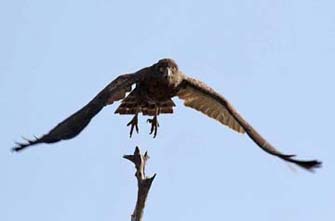
Another fabulous day in the stunning Valley…